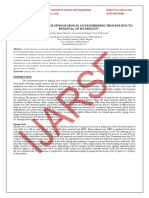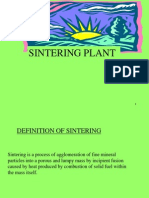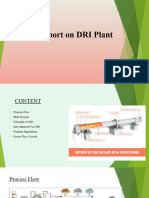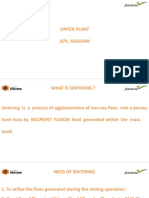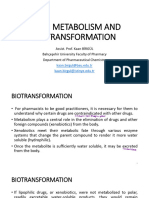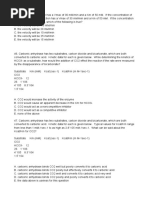78%(9)78% found this document useful (9 votes)
5K viewsSinter Plant Presentation (Sinter Operation)
Sinter Plant Presentation (Sinter Operation)
Uploaded by
aashulhedaThis document provides information about the sinter plant at JSW Dolvi Works Steel Limited in Dolvi, India. It discusses the introduction and commissioning details of the sinter plant, as well as the raw materials and processes involved in sinter production, including flux crushing, fuel crushing, raw material proportioning, mixing and charging, ignition, and cooling. Key details provided include plant capacity and commissioning date, raw material chemistries and consumptions, equipment used, and quality of the final sinter product.
Copyright:
© All Rights Reserved
Available Formats
Download as PPT, PDF, TXT or read online from Scribd
Sinter Plant Presentation (Sinter Operation)
Sinter Plant Presentation (Sinter Operation)
Uploaded by
aashulheda78%(9)78% found this document useful (9 votes)
5K views30 pagesThis document provides information about the sinter plant at JSW Dolvi Works Steel Limited in Dolvi, India. It discusses the introduction and commissioning details of the sinter plant, as well as the raw materials and processes involved in sinter production, including flux crushing, fuel crushing, raw material proportioning, mixing and charging, ignition, and cooling. Key details provided include plant capacity and commissioning date, raw material chemistries and consumptions, equipment used, and quality of the final sinter product.
Original Description:
jsw
Copyright
© © All Rights Reserved
Available Formats
PPT, PDF, TXT or read online from Scribd
Share this document
Did you find this document useful?
Is this content inappropriate?
This document provides information about the sinter plant at JSW Dolvi Works Steel Limited in Dolvi, India. It discusses the introduction and commissioning details of the sinter plant, as well as the raw materials and processes involved in sinter production, including flux crushing, fuel crushing, raw material proportioning, mixing and charging, ignition, and cooling. Key details provided include plant capacity and commissioning date, raw material chemistries and consumptions, equipment used, and quality of the final sinter product.
Copyright:
© All Rights Reserved
Available Formats
Download as PPT, PDF, TXT or read online from Scribd
Download as ppt, pdf, or txt
78%(9)78% found this document useful (9 votes)
5K views30 pagesSinter Plant Presentation (Sinter Operation)
Sinter Plant Presentation (Sinter Operation)
Uploaded by
aashulhedaThis document provides information about the sinter plant at JSW Dolvi Works Steel Limited in Dolvi, India. It discusses the introduction and commissioning details of the sinter plant, as well as the raw materials and processes involved in sinter production, including flux crushing, fuel crushing, raw material proportioning, mixing and charging, ignition, and cooling. Key details provided include plant capacity and commissioning date, raw material chemistries and consumptions, equipment used, and quality of the final sinter product.
Copyright:
© All Rights Reserved
Available Formats
Download as PPT, PDF, TXT or read online from Scribd
Download as ppt, pdf, or txt
You are on page 1of 30
PM Trophy 2012-13
< department >
JSW Dolvi Works
Steel Limited
Steel ltd.
Sinter Plant
Dolvi
Introduction of Sinter Plant
Commissioning Details
Raw materials for Sintering Process
Product Sinter Quality
Specific Consumptions
Major Equipments
Sinter Plant Layout
a) Flux Crushing & Screening
b) Fuel Crushing
c) Raw material proportioning
d) Material charging to Sinter machine
e) Ignition of Raw mix
f) Sinter Cooling
g) Product Screening & Dispatch
Photograph of Product Sinter
Contact Numbers of department Personnel
Contents:
Dolvi
Introduction to Sinter Plant
Integrated steel plants generate a lot of waste from the
various units which are rich in metallurgical content. For
Example :
BF - Iron ore fines, Sinter fines, Pellet fines, Coke fines &
Flue Dust
SMS - Slag, Gas cleaning plant dust
Sponge Iron Plant SIP Sludge, Iron Ore fines
Rolling Mill - Mill scale
Iron Ore mines Iron Ore fines
Sintering process caught attention of steel plant managers
around
the world to take care of waste generated in the steel plant
and the fines generated in the mines.
Dolvi
Plant Commissioning Details
Plant Capacity : 2.24 Million tons Per Annum
@ 6653 tpd with 337 working
days
Date Of Commissioning : 15th December 2005
Plant & Equipment Design : C M I, China
Equipment Supply : MECC, China
Area Of Plant : 465 mt X 220 mt
Dolvi
Raw Materials for Sintering Process
Iron Ore : 1. Fines Purchased from various sources
2. Fines from SIP
Coke : 1. Under size (<15mm) generated at BF is crushed to
<3 mm
2. <10mm coke fines is purchased and crushed to
<3mm
Lime Stone : 1. Purchased from outside sources and crushed to
<3mm
2. Limestone fines (<40mm) return from LCP
Dolomite : 1. Purchased from outside sources and crushed to
<3mm
Calcined Lime : Purchased from outside as 0 3 mm in crushed
form.
Plant Secondary Materials:
SIP Sludge
Mill Scale
GCP Dust
EAF Slag
Flue Dust
Furnace Fuel: BF Gas enriched with RLNG
Dolvi
RAW MATERIAL CHEMICAL ANALYSIS
SL.
No
.
Raw Material
Fe
(%)
Silica
(%)
Alumina
(%)
CaO
(%)
MgO
(%)
Fixed
Carbon
(%)
Moisture
(%)
Ash
(%)
1 Iron Ore Fines 62.05 3.95 3.15 0.25 0.05 7
2
Sinter Fines
(BF + Sinter)
56.23 4.7 3.73 9.81 1.69
3 Limestone 1.63 1.39 0.37 49.98 3.61 1.1
4 Quicklime 0.22 1.87 0.42 92.24 1.79
5 Dolomite 0.67 1.04 0.47 33.4 18.43 0.38
6 Coke Breeze 86.74 8 - 10 9.66
7 Mill Scale 70.48 1.62 0.62 0.73 0.08 4.16
8 SIP sludge 62.59 3.9 1.9 3.58 1.02 1.5 15.42
9 GCP Dust 56.22 1.91 2.14 9.45 2.81 1.13
10 Flue Dust 27.7 12.49 3.87 8.8 0.85 26.85 10.53
Dolvi
Product Quality
Chemical Analysis: Physical Analysis:
Total Fe : 56 % min Product Size: 5 50 mm
FeO : 10.5 11.5% +50 mm : 5% max
SiO2 : 5.0% max 0 - 5 mm : 5% max
Al2O3 : < 3.3 % T. I :>72
CaO : 9.0 10.0 %
Basicity : 2.0 2.4
Product Sinter Quality :
Dolvi
Specific Consumptions
IBRM : 995 kg / Ton of Sinter
Lime Stone : 35 kg / Ton of Sinter
Dolomite : 80 kg / Ton of Sinter
Coke Breeze : 65 kg / Ton of Sinter
Quick Lime : 26 kg / Ton of Sinter
Electric Power : 36 kwhr / Ton of Sinter
Water : 0.15 m3 /Ton of Sinter
RLNG gas : 1.5 Sm3 / Ton of Sinter
BF Gas : 10.0 Nm3 / Ton of Sinter
Oxygen : 2.0 Nm3 / Ton of Sinter
Dolvi
Major Equipments:
Main Suction Fan :18500 Cu mt per min
Sinter Machine : 198 Sq. mt
Ignition Furnace : 2Row vertical Burners (12+11)
Hot Sinter Crusher : 3500 LongX 1700 Dia
Circular Cooler : 228 Sq. mt
Primary Mixing Drum : 3.2mt Dia x12mt Long
Nodulizing Drum : 3.8mt Dia x117.5mt Long
Primary Sinter Screen : 480TPH (2500X8000)
Secondary Sinter Screen : 300TPH (2500X8000)
Conveyor System : 48 Nos ( Belt Length 2.5 KM)
Dolvi
SINTER PLANT LAYOUT
Dolvi
SUB-PROCESS FLUX CRUSHING & SCREENING
1) Flux Crushing and Screening is a Closed Loop Process.
1.1 )Flux (0-50mm) received from conveyor F-4 will be unloaded into
2 surge bunkers, each holding effective volume of 85 m3 for storage
of 270 metric tons.
1.2 )Hammer crusher is used to crush materials having size 0-50mm
into 0-3mm (85%). The incoming flux materials are Limestone and
Dolomite coming from conveyors F5 &F6 is crushed in to required
size and falling to conveyor F7 through discharge chute. When rotor
rotates feed comes in contact between hammers and great carrier
liners causing crushing of flux
1.3 ) After Hammer Crusher material is further screened to 0-3mm
and sent to proportioning building and Oversize material sent to
hammer Crusher for further crushing.
Dolvi
Surge bunkers for
primary storage
Hammer Crusher 112B
Hammer
Crusher
112A
F-5 conveyor
F-6 conveyor
F-7 conveyor
F-8 conveyor F-9 conveyor
Flux screen B Flux screen A
F-10
Surge bunkers for
secondary storage
Dolomite Lime stone
Lime stone
Dolomite
Lime stone Dolomite
To Proportional building
PROCESS FLOW- FLUX CRUSHING
AND SCREENING
F-4 conveyor
Dolvi
SUB-PROCESS FUEL CRUSHING
1) The process involves Crushing of Fuel (coke breeze) and Flux
which includes:
A) Primary Crushing of Coke breeze
B) Secondary crushing of Coke breeze
2) Fuel (coke breeze) crushing is done for obtaining required
crushing index (90%) and can be used in sintering
process.
3) To meet the production and process requirement, coke
discharged from Double Roll Crusher 900 Dia. X 900mm is fed to 3
nos. of Four Roll Crusher to ensure that minimum 85% of
3 0 mm fraction in crushed coke breeze will be supplied to Raw
material Proportioning building.
Dolvi
4 Roller crusher A,B &C
Double roller crusher
Coke bins
Conveyor C-2
Coke bunkers
Plough
Magnetic iron separator
C-4 conveyor
C-8 conveyor
Conveyor C-7
C-6 C-5
Magnetic iron separator
Conveyor C-3
To proportioning building
14
PROCESS FLOW - FUEL CRUSHING
Dolvi
RAW MATERIAL PROPORTIONING
The raw materials are stored in the bunkers.
Description : Bunkers 1 to 20
Bunker 1&2 Quicklime
Bunker 3 - ESP Dust
Bunker 4 - Limestone fines
Bunker 5&6 - Dolomite fines
Bunker 7&8 - Coke breeze
Bunker 9 to 18- Iron ore fines
Bunker 19&20 - Return fines
WMRS Bunkers (1-4) : Secondary Materials ( SIP Sludge, Mill
Scale, Flue dust, GCP Dust, EAF Slag)
Materials are proportioned in a ratio to obtain desired Sinter
Chemistry and extracted with the help of Weigh Feeders/Round disc
feeders and fed on to main gathering conveyor (M-1) and then
discharged into Primary Mixer
Dolvi
GROUND HOPPER
WBC-2
WRSC-1
WF-1 WF-2 WF-3 WF-4
WB-1 WB-2 WB-3
WB-4
WASTE RECYCLING BUILDING
GH-1 GH-2
SECONDARY MATERIAL RECYCLING
Dolvi
M-1
B 19 B 20 B 18 B 17 B 16 B 15 B 14 B 13 B 12 B 11 B 10 B 9 B 8 B 7 B 6 B 5 B 4 B 3 B 2 B 1
R-3 I-1 C-11
F-13
BC-55
ROUND DISC
FEEDER
D-1
C-10 WBC-3
PNEUMATIC
CONVEYOR
F-12 WEIGH FEEDER
PROPORTIONING BUILDING
17
PROCESS FLOW : RAW MATERIAL PROPORTIONING
Dolvi
MIXING and MATERIAL CHARGING TO SINETR
MACHINE
1 The process involves Dry mixing inside Primary mixing drum
(Mixer-1) and Nodulizing inside Secondary mixing drum (Mixer-2) and
finally charging it onto Sinter Machine.
2 Water is sprayed inside Secondary mixer to maintain Moisture
content of Raw mix to 7.5+/-0.5 as per process requirement as it helps
in nodulizing
3 Steam is also added in Secondary mixer for preheating of Raw mix
4 Raw mix is then discharged in Raw mix bin via Belt conveyors
5 Raw mix is charged onto Sinter machine with the help of Drum
Feeder and Segregation Plate
Dolvi
M4
Shuttle Conveyor
Raw Mix Hopper
Drum Feeder
Sinter Machine
Segregation Plate
B1
B2
B3
M3
Hearth
Layer Hopper
M2
Mixer-2
Mixer-1
From
Proportioning
M-1
MIXING and MATERIAL CHARGING TO SINETR MACHINE
Dolvi
20
MATERIAL CHARGING & IGNITION
SUBGATE
Leveler
Unclean Air from Cooler
Clean Air
from Cooler
Dolvi
The process involves Ignition of raw mix after material charging to
sinter machine
Ignition is done for,
a) To Dry top layer of sinter bed and initiate combustion of Carbon.
Ignition furnace consists of::
a) Two rows of total 23 Nos. burners are installed on the roof
of the ignition furnace. The first row consists of 11 nos.
burners and the second row has 12 nos.
Two numbers of opening are provided on roof for installation of
temperature measurement, 4 nos. inspection openings on side wall of
furnace hearth and two inspection openings on side wall of annealing
hood.
Gaseous Fuels used are BF Gas and RLNG gas to maintain Furnace
temperature 1150 +/- 50 Deg. C:
RAW MIX IGNITION
Dolvi
Ignition of Raw mix
Sinter Machine
Burners
BF Gas Line
Ignition Air Line
22
Dolvi
Zones in sintering
Dolvi
RAW MIX IGNITION
1) The Raw mix is deposited in a layer of 600-700mm height in the
Sinter strand.
2) The hearth layer is deposited in a layer of 40 mm height below
raw mix
3) The Sintering Process starts with ignition of top layer with Fan
sucking the heated air down through the sinter bed. The fuels in
the bed generate the heat to melt and fuse the Ore particles
together.
4) At the end of sinter strand the flame front has passed all the way
through the raw mix to the bottom.
5) The sinter cake then drops off at the end of strand on Single roll
crusher and charged on Circle cooler
Dolvi
SINTERING contd
Reduction of Hematite:
3Fe2 O3 + CO 2Fe3 O4 + CO2
Hematite Magnetite
Fe3O4 + CO 3 FeO + CO2
Dissociation of Carbonates:
CaCO3 CaO + CO2
MgCO3 MgO + CO2
Dolvi
SINTER COOLING
1) The process involves Cooling of sinter inside circle cooler.
2) The sinter cake discharged from the hot sinter breaker, 120 ~ 0 mm,
at temperature of 750 ~ 850 deg. C in average is charged into circular
sinter cooler.
3) Product Sinter temperature should be reduced down to < 100deg.
C for easy handling by belt conveyor and down stream equipment.
4) To achieve this performance a circular sinter cooler with effective
area of 228 m2 is provided along with 4 nos. of cooling blowers to
supply sufficient cooling air to the cooler.
5) The heat from Cooler is utilized in two ways:
a) Steam is generated via waste heat recovery Boiler and added in
Mixer-2 to preheat raw mix
b) Unclean Hot air is provided in Annealing hood after Ignition
Dolvi
1) The process involves Screening of Product Sinter i.e. +5 mm for BF
, -5 mm as return sinter and 12 mm to 20 mm as hearth layer.
2) Size of product sinter plays utmost importance in productivity of
hot metal (BF). Also a product sinter size of 12 mm-20 mm is required
as hearth layer for better suction and protection from grate bar
damage.
3) Sinter product screening is done via two route P2 & P3 each
equipped with three vibrating screens of different mesh size.
4) The two route is divided from P1 discharge through Y chute. Each
route is equipped with three different vibrating screens of size 12
mm,20 mm & 5 mm respectively.
PRODUCT SCREENING
Dolvi
P-1
P-2
P-3
P-4 B-1
B-2
B-3
P-7
P-5
P-6
P-8
P-9
R-1
P-10
BC-56
SCREEN
512
SCREEN
513
SCREEN
522
SCREEN
523
S
SCREEN
515
SCREEN
525
BASE
MATERIAL
BIN
HOPPER
28
PRODUCT SCREENING LAYOUT
Dolvi
Product Sinter
Dolvi
You might also like
- Pellet Plant Presentation-2019Document42 pagesPellet Plant Presentation-2019syed fazlulla hussain0% (1)
- Yield CalculationDocument1 pageYield Calculationssnanda1100% (5)
- Pre-Feasibility Report: Ankur Udyog Limited (Steel Division)Document38 pagesPre-Feasibility Report: Ankur Udyog Limited (Steel Division)فردوس سليمان100% (2)
- JSW Recovery Coke OvenDocument20 pagesJSW Recovery Coke OvenStarluck shine75% (4)
- Experiment 5 - Double Indicator TitrationDocument16 pagesExperiment 5 - Double Indicator TitrationJoemer Absalon Adorna71% (7)
- Sponge Iron PlantDocument11 pagesSponge Iron PlantLi Gary100% (1)
- Sinter PlantDocument14 pagesSinter PlantKannan ThangarajuNo ratings yet
- Coke Oven PlantDocument45 pagesCoke Oven PlantSameer Shekhar100% (1)
- Repot On SMS-2 JSPL, Raigarh FinalDocument45 pagesRepot On SMS-2 JSPL, Raigarh FinalRahul Pandey100% (2)
- Sponge Iron Heat & Mass BalanceDocument33 pagesSponge Iron Heat & Mass BalanceNILESH JAIN100% (2)
- Sponge IronDocument15 pagesSponge IronMOHNISHKUMARJHA100% (1)
- A Report On Steel Melting ShopDocument18 pagesA Report On Steel Melting ShopRahul PandeyNo ratings yet
- Coke Oven HeatingDocument12 pagesCoke Oven HeatingSatyajit ray ChoudhuryNo ratings yet
- 1.2 MptpappDocument32 pages1.2 MptpappsourajpatelNo ratings yet
- Iron Ore Pellet Is at IonDocument19 pagesIron Ore Pellet Is at Ionvivekojha14645100% (1)
- International Business Machine-Case Analysis: Strategic Management AssignmentDocument6 pagesInternational Business Machine-Case Analysis: Strategic Management AssignmentaashulhedaNo ratings yet
- OCR Chemistry A: 9 Enthalpy Exam-Style QuestionsDocument6 pagesOCR Chemistry A: 9 Enthalpy Exam-Style QuestionsHazare 2004100% (1)
- Red Lion Path-DryDocument2 pagesRed Lion Path-Drytravellerfellow50% (2)
- Sponge Iron PlantDocument12 pagesSponge Iron PlantASHISH MOHAPATRANo ratings yet
- Sintering Plant at A GlanceDocument72 pagesSintering Plant at A GlanceShailesh Kumar100% (1)
- Stock HouseDocument27 pagesStock HousePrince Kumar100% (1)
- Tata SteelDocument32 pagesTata Steelpatrik710No ratings yet
- A Presentation On Dri-Ii: BY:-Vikash Ranjan Sharma Metallurgy - 5 SEM 3203810051Document15 pagesA Presentation On Dri-Ii: BY:-Vikash Ranjan Sharma Metallurgy - 5 SEM 3203810051Rahul PandeyNo ratings yet
- Sintering Plant at A GlanceDocument72 pagesSintering Plant at A Glanceskt9560100% (1)
- Sinter PlantDocument38 pagesSinter PlantRahul Pandey83% (6)
- Sinter Write UpDocument262 pagesSinter Write Uprmsh301No ratings yet
- Sinter PlantDocument12 pagesSinter PlantRajan Bhandari100% (1)
- Sponge IronDocument23 pagesSponge Ironhijzain0% (1)
- Dri InternshipDocument38 pagesDri InternshipGuruprasad Sanga100% (3)
- Coke Oven JSPL Raigarh ChhattisgarhDocument28 pagesCoke Oven JSPL Raigarh ChhattisgarhAviNo ratings yet
- Abstract On Iron Ore Pelletisation (Grate Kiln System) PDFDocument17 pagesAbstract On Iron Ore Pelletisation (Grate Kiln System) PDFAyush tiwariNo ratings yet
- Rashmi MataliksDocument49 pagesRashmi Mataliksgem_bhavesh100% (1)
- Sinter Making0260307Document47 pagesSinter Making0260307honeygupta12150% (2)
- Blast Furnace Iron Making IIT KGP Oct 26 2010Document85 pagesBlast Furnace Iron Making IIT KGP Oct 26 2010Samanway Das100% (1)
- Dri PPT (New)Document9 pagesDri PPT (New)VikramNo ratings yet
- An Introductory Presentation On Coke Oven PlantDocument32 pagesAn Introductory Presentation On Coke Oven PlantRohit Vijayvargiya67% (6)
- Iron Ore PelletizationDocument20 pagesIron Ore Pelletizationxarnix50% (2)
- Sintering ProcessDocument4 pagesSintering ProcessNicollas Matheus100% (1)
- A Report On Steel Melting ShopDocument18 pagesA Report On Steel Melting ShopRahul PandeyNo ratings yet
- Sintering PlantDocument24 pagesSintering PlantB R Manikyala Rao100% (1)
- Tata Steel Report SubmittedDocument32 pagesTata Steel Report SubmittedSnehasisDasNo ratings yet
- DSP PlantSpecificDocument33 pagesDSP PlantSpecificTapas Banerjee100% (2)
- Grate KilnDocument8 pagesGrate KilnAnggiet HerdayantiNo ratings yet
- NMDCDocument31 pagesNMDCRavi TejaNo ratings yet
- Presentation On DRIDocument13 pagesPresentation On DRISandip maji100% (2)
- Coal Based Sponge Iron IndustryDocument4 pagesCoal Based Sponge Iron IndustrychaitanyabhansaliNo ratings yet
- Eesar Steel ReportDocument34 pagesEesar Steel ReportchinmaiNo ratings yet
- Sponge Iron Project ProfileDocument6 pagesSponge Iron Project ProfilevuonghnNo ratings yet
- Sinter Plant JSPL, RaigarhDocument14 pagesSinter Plant JSPL, RaigarhJatin BangaliNo ratings yet
- EIA NMDC Pellet PlantDocument437 pagesEIA NMDC Pellet Plantkselvan_1No ratings yet
- Direct Reduced Iron - IspatGuruDocument17 pagesDirect Reduced Iron - IspatGuruSanjeet KumarNo ratings yet
- MSPL Final ReportDocument53 pagesMSPL Final ReportKiran RawalNo ratings yet
- Iron Ore Pelletizing: Metso Grate-Kiln SystemsDocument2 pagesIron Ore Pelletizing: Metso Grate-Kiln Systemsmbamarketing54No ratings yet
- DSP Overview 10-07-2017Document46 pagesDSP Overview 10-07-2017Binod Kumar Padhi0% (1)
- Alternative Route of Iron Making - IGIT NoteDocument75 pagesAlternative Route of Iron Making - IGIT NoteIgit Sarang Placement Cell100% (3)
- Sms ProcessDocument7 pagesSms ProcessAnonymous p4GdtQpNo ratings yet
- Jindal Steel PlantDocument23 pagesJindal Steel PlantPramodPradhan100% (1)
- FS Dri 01Document50 pagesFS Dri 01فردوس سليمان100% (1)
- Coal Handling Plant: at Heads of CHP MeetDocument46 pagesCoal Handling Plant: at Heads of CHP MeetMANISH SHARMA100% (2)
- Direct Reduction of Iron ProcessDocument84 pagesDirect Reduction of Iron ProcessAmit Kumar SinghNo ratings yet
- SP Brief Description1Document12 pagesSP Brief Description1Creative MindsNo ratings yet
- INDEX: Contents of The ReportDocument34 pagesINDEX: Contents of The Reportrahul rayNo ratings yet
- RMP 1Document10 pagesRMP 1Anonymous l5X3VhTNo ratings yet
- An Industrial Visit To BSRMDocument8 pagesAn Industrial Visit To BSRMMd. Sayem ShahriarNo ratings yet
- 11 Working Capital ManagementDocument34 pages11 Working Capital Managementaashulheda100% (1)
- 11 Working Capital ManagementDocument34 pages11 Working Capital Managementaashulheda100% (1)
- Erm 101Document30 pagesErm 101aashulhedaNo ratings yet
- Ln-8 Idle Mind Solutions: A 1 E A R 1 T 1 1 T 2Document22 pagesLn-8 Idle Mind Solutions: A 1 E A R 1 T 1 1 T 2aashulhedaNo ratings yet
- Resistance Seam WeldingDocument7 pagesResistance Seam WeldingaashulhedaNo ratings yet
- FiltrasiDocument4 pagesFiltrasiRusydinaNo ratings yet
- Volume.7. Design and Manufacturing of Hydraulic PressesDocument62 pagesVolume.7. Design and Manufacturing of Hydraulic PressesQ.S.Khan100% (5)
- Bio Deg PolymerDocument19 pagesBio Deg PolymerSivasankar JeyabaskaranNo ratings yet
- CH 11 - Writing - Chemical - Equation - 1 - AnsDocument2 pagesCH 11 - Writing - Chemical - Equation - 1 - AnsOlivia LinNo ratings yet
- 2-Drug Metabolism and BiotransformationDocument138 pages2-Drug Metabolism and BiotransformationsedasunkarNo ratings yet
- Astm D1411Document5 pagesAstm D1411pipeNo ratings yet
- Lesson 26Document4 pagesLesson 26MarcTnnNo ratings yet
- 09-S and P Block Elements - Set-Test-Final-EDocument3 pages09-S and P Block Elements - Set-Test-Final-EAbhishek RavirajNo ratings yet
- Raj Kario PDFDocument4 pagesRaj Kario PDFjayNo ratings yet
- Handbook of Materials For ASMDocument3 pagesHandbook of Materials For ASMLilian RoseNo ratings yet
- AppliedchemistrylabmaualDocument23 pagesAppliedchemistrylabmaualYashwanth KasthuriNo ratings yet
- Grade 8 Lesson 2Document33 pagesGrade 8 Lesson 2Mary Joy LanuzaNo ratings yet
- Fontargen AJ PDFDocument282 pagesFontargen AJ PDFantonyNo ratings yet
- Heat Treatment Effect On P91 SteelDocument7 pagesHeat Treatment Effect On P91 SteelChandan PandeyNo ratings yet
- Revised Fundamentals of Volumetric AnalysisDocument13 pagesRevised Fundamentals of Volumetric AnalysisMahesh Kumar100% (1)
- Dispersion of Super Paramagnetic Iron Oxide Nanoparticles in Poly (D, L-Lactide-Co-Glycolide) MicroparticlesDocument6 pagesDispersion of Super Paramagnetic Iron Oxide Nanoparticles in Poly (D, L-Lactide-Co-Glycolide) MicroparticlesPpa Gpat AmitNo ratings yet
- Calculations and Solutions: SolutionDocument7 pagesCalculations and Solutions: SolutionHikmat UllahNo ratings yet
- Merran A. Daniel - Polyurethane Binder Systems For Polymer Bonded ExplosivesDocument34 pagesMerran A. Daniel - Polyurethane Binder Systems For Polymer Bonded ExplosivesYamveaNo ratings yet
- GR - 9 Chemistry SSE Revision 2023-24Document3 pagesGR - 9 Chemistry SSE Revision 2023-24Avaneesh SinghNo ratings yet
- Application Quat Pesticide Analysis Agilent Sampliq WCX Spe 5994 1307en AgilentDocument4 pagesApplication Quat Pesticide Analysis Agilent Sampliq WCX Spe 5994 1307en AgilentJaycer AsbyssNo ratings yet
- JP Xvii 2016Document44 pagesJP Xvii 2016Harrizul RivaiNo ratings yet
- A173 enDocument12 pagesA173 enRaj BrothersNo ratings yet
- GUID - 3 en-USDocument13 pagesGUID - 3 en-USdeepaNo ratings yet
- Chapter2 HMFDocument274 pagesChapter2 HMFTaeu YuNo ratings yet
- 35905.divert S Acid System - Overview.0612Document1 page35905.divert S Acid System - Overview.0612paimanNo ratings yet
- Material Safety Data SheetDocument29 pagesMaterial Safety Data SheetJorellie PetalverNo ratings yet
- Machine Shop Practice Reviewer 3Document11 pagesMachine Shop Practice Reviewer 3Ruth LauronNo ratings yet










